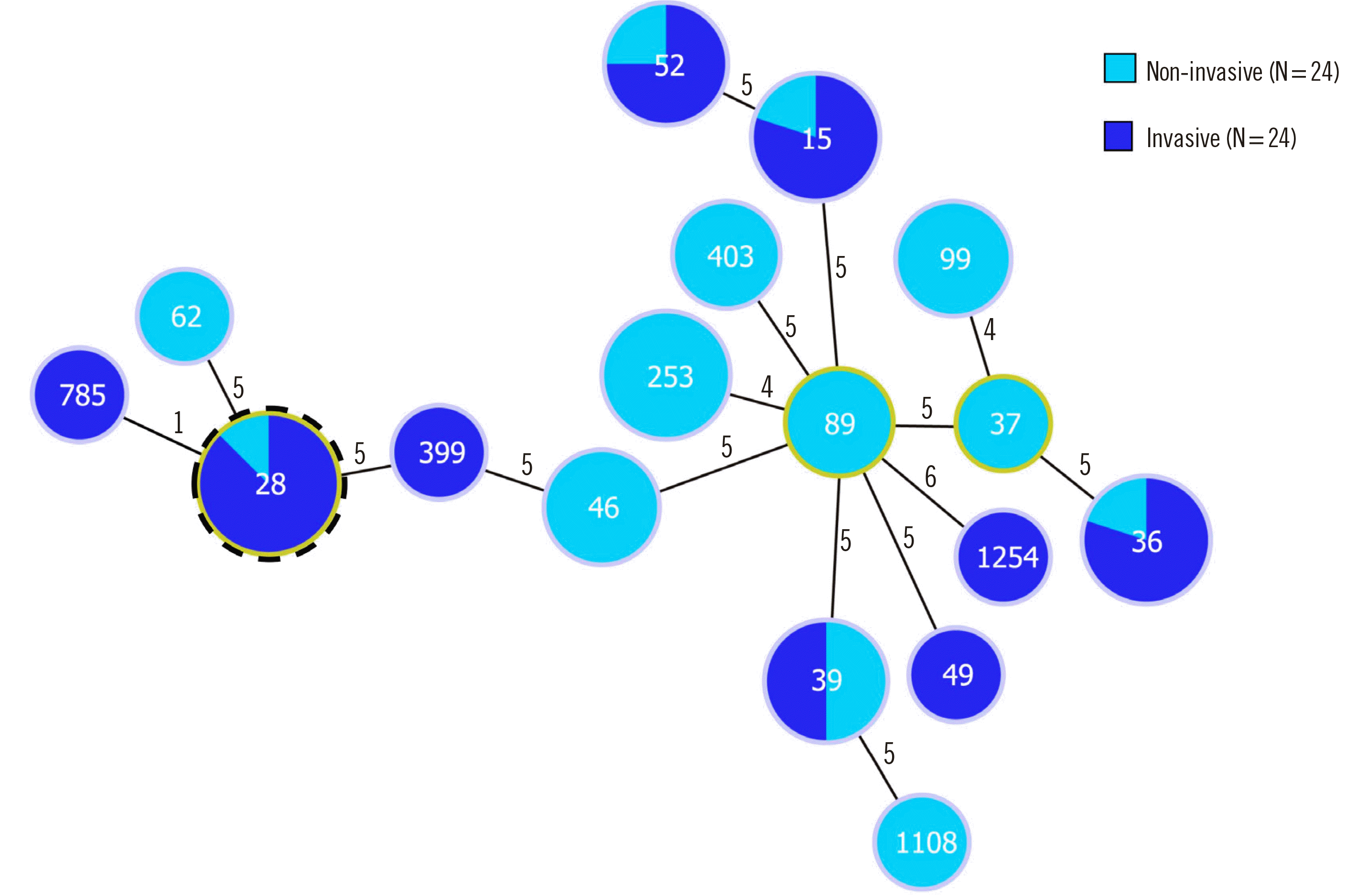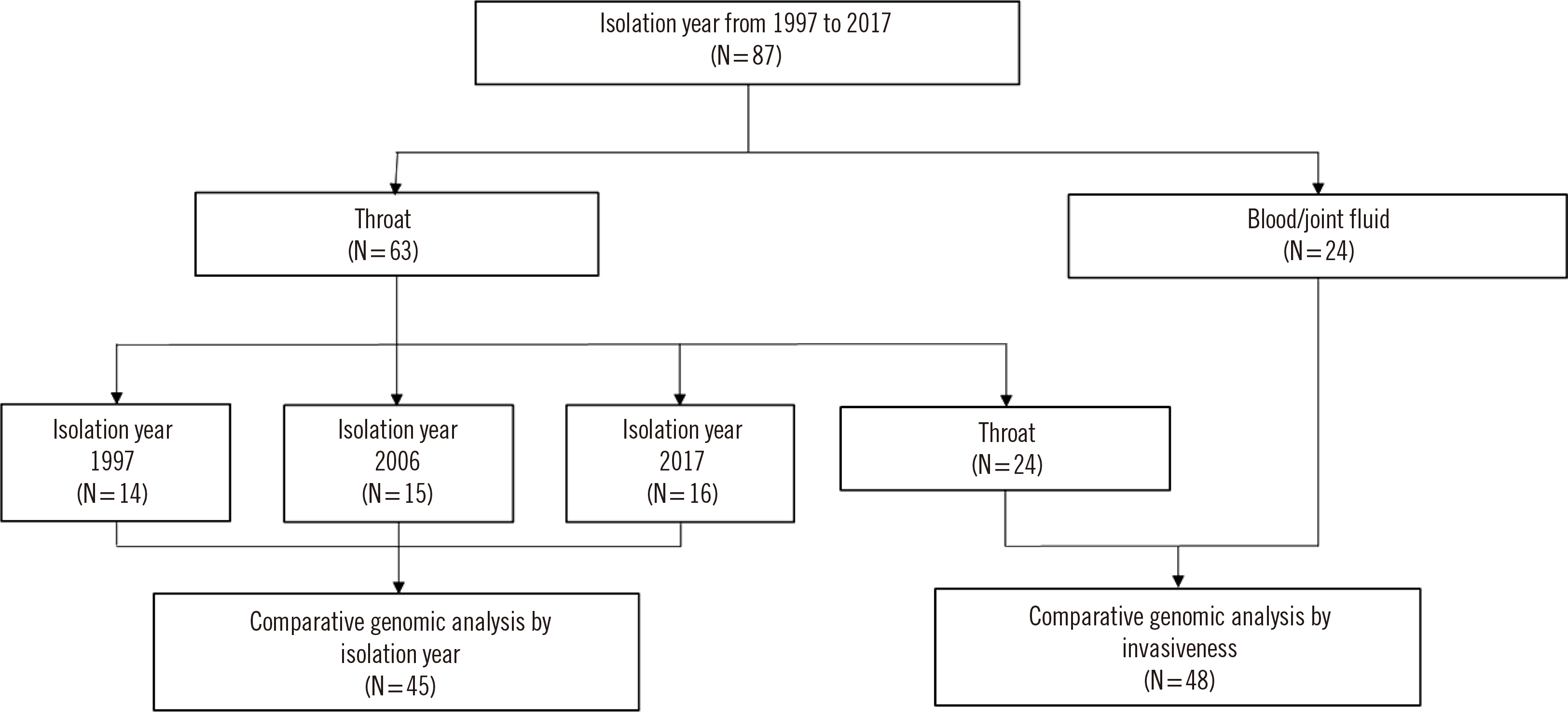1. Stevens DL, Tanner MH, Winship J, Swarts R, Ries KM, Schlievert PM, et al. 1989; Severe group A streptococcal infections associated with a toxic shock-like syndrome and scarlet fever toxin A. N Engl J Med. 321:1–7. DOI:
10.1056/NEJM198907063210101. PMID:
2659990.

2. Carapetis JR, Steer AC, Mulholland EK, Weber M. 2005; The global burden of group A streptococcal diseases. Lancet Infect Dis. 5:685–94. DOI:
10.1016/S1473-3099(05)70267-X. PMID:
16253886.

3. Enright MC, Spratt BG, Kalia A, Cross JH, Bessen DE. 2001; Multilocus sequence typing of
Streptococcus pyogenes and the relationships between
emm type and clone. Infect Immun. 69:2416–27. DOI:
10.1128/IAI.69.4.2416-2427.2001. PMID:
11254602. PMCID:
PMC98174.

4. Luca AV, Giovanni G, Dezemona P. Pulsed field gel electrophoresis of group A streptococci. Methods Mol Biol. 2015; 1301:129–38. DOI:
10.1007/978-1-4939-2599-5_12. PMID:
25862054.
5. Lewis T, Loman NJ, Bingle L, Jumaa P, Weinstock GM, Mortiboy D, et al. 2010; High-throughput whole-genome sequencing to dissect the epidemiology of
Acinetobacter baumannii isolates from a hospital outbreak. J Hosp Infect. 75:37–41. DOI:
10.1016/j.jhin.2010.01.012. PMID:
20299126.

6. Schuchat A, Hilger T, Zell E, Farley MM, Reingold A, Harrison L, et al. 2001; Active bacterial core surveillance of the emerging infections program network. Emerg Infect Dis. 7:92–9. DOI:
10.3201/eid0701.010114. PMID:
11266299. PMCID:
PMC2631675.

7. Hyatt D, Chen GL, LoCascio PF, Land ML, Larimer FW, Hauser LJ. 2010; Prodigal: prokaryotic gene recognition and translation initiation site identification. BMC Bioinformatics. 11:1–11. DOI:
10.1186/1471-2105-11-119. PMID:
20211023. PMCID:
PMC2848648.

8. Chun J, Grim CJ, Hasan NA, Lee JH, Choi SY, Haley BJ, et al. 2009; Comparative genomics reveals mechanism for short-term and long-term clonal transitions in pandemic
Vibrio cholerae. Proc Natl Acad Sci U S A. 106:15442–7. DOI:
10.1073/pnas.0907787106. PMID:
19720995. PMCID:
PMC2741270.
10. Takahashi T, Arai K, Lee DH, Koh EH, Yoshida H, Yano H, et al. 2016; Epidemiological study of erythromycin-resistant
Streptococcus pyogenes from Korea and Japan by
emm genotyping and multilocus sequence typing. Ann Lab Med. 36:9–14. DOI:
10.3343/alm.2016.36.1.9. PMID:
26522753. PMCID:
PMC4697353.

11. Kim S, Byun JH, Park H, Lee J, Lee HS, Yoshida H, et al. 2018; Molecular epidemiological features and antibiotic susceptibility patterns of
Streptococcus dysgalactiae subsp.
equisimilis isolates from Korea and Japan. Ann Lab Med. 38:212–9. DOI:
10.3343/alm.2018.38.3.212. PMID:
29401555. PMCID:
PMC5820065.

12. Tamayo E, Montes M, Vicente D, Pérez-Trallero E. 2016;
Streptococcus pyogenes pneumonia in adults: clinical presentation and molecular characterization of isolates 2006-2015. PLoS One. 11:e0152640. DOI:
10.1371/journal.pone.0152640. PMID:
27027618. PMCID:
PMC4814053.
13. Sakai T, Taniyama D, Takahashi S, Nakamura M, Takahashi T. 2017; Pleural empyema and streptococcal toxic shock syndrome due to
Streptococcus pyogenes in a healthy Spanish traveler in Japan. IDCases. 9:85–8. DOI:
10.1016/j.idcr.2017.06.006. PMID:
28725562. PMCID:
PMC5506862.

14. Takahashi T, Maeda T, Lee S, Lee DH, Kim S. 2020; Clonal distribution of clindamycin-resistant erythromycin-susceptible (CRES)
Streptococcus agalactiae in Korea based on whole genome sequences. Ann Lab Med. 40:370–81. DOI:
10.3343/alm.2020.40.5.370. PMID:
32311850. PMCID:
PMC7169627.

15. Larsen MV, Cosentino S, Rasmussen S, Friis C, Hasman H, Marvig RL, et al. 2012; Multilocus sequence typing of total-genome-sequenced bacteria. J Clin Microbiol. 50:1355–61. DOI:
10.1128/JCM.06094-11. PMID:
22238442. PMCID:
PMC3318499.

16. Nascimento M, Sousa A, Ramirez M, Francisco AP, Carriço JA, Vaz C. 2017; PHYLOViZ 2.0: providing scalable data integration and visualization for multiple phylogenetic inference methods. Bioinformatics. 33:128–9. DOI:
10.1093/bioinformatics/btw582. PMID:
27605102.

17. Steer AC, Law I, Matatolu L, Beall BW, Carapetis JR. 2009; Global
emm type distribution of group A streptococci: systematic review and implications for vaccine development. Lancet Infect Dis. 9:611–6. DOI:
10.1016/S1473-3099(09)70178-1. PMID:
19778763.
18. Luca-Harari B, Darenberg J, Neal S, Siljander T, Strakova L, Tanna A, et al. 2009; Clinical and microbiological characteristics of severe
Streptococcus pyogenes disease in Europe. J Clin Microbiol. 47:1155–65. DOI:
10.1128/JCM.02155-08. PMID:
19158266. PMCID:
PMC2668334.

19. Ekelund K, Darenberg J, Norrby-Teglund A, Hoffmann S, Bang D, Skinhøj P, et al. 2005; Variations in
emm type among group A streptococcal isolates causing invasive or noninvasive infections in a nationwide study. J Clin Microbiol. 43:3101–9. DOI:
10.1128/JCM.43.7.3101-3109.2005. PMID:
16000420. PMCID:
PMC1169105.

20. Enright MC, Day NP, Davies CE, Peacock SJ, Spratt BG. 2000; Multilocus sequence typing for characterization of methicillin-resistant and methicillin-susceptible clones of
Staphylococcus aureus. J Clin Microbiol. 38:1008–15. DOI:
10.1128/JCM.38.3.1008-1015.2000. PMID:
10698988. PMCID:
PMC86325.

21. Feil EJ, Li BC, Aanensen DM, Hanage WP, Spratt BG. 2004; eBURST: inferring patterns of evolutionary descent among clusters of related bacterial genotypes from multilocus sequence typing data. J Bacteriol. 186:1518–30. DOI:
10.1128/JB.186.5.1518-1530.2004. PMID:
14973027. PMCID:
PMC344416.

23. Nozawa T, Furukawa N, Aikawa C, Watanabe T, Haobam B, Kurokawa K, et al. 2011; CRISPR inhibition of prophage acquisition in
Streptococcus pyogenes. PLoS One. 6:e19543. DOI:
10.1371/journal.pone.0019543. PMID:
21573110. PMCID:
PMC3089615.
24. Heuston S, Begley M, Gahan CGM, Hill C. 2012; Isoprenoid biosynthesis in bacterial pathogens. Microbiology (Reading). 158:1389–401. DOI:
10.1099/mic.0.051599-0. PMID:
22466083.

25. Voynova NE, Rios SE, Miziorko HM. 2004;
Staphylococcus aureus mevalonate kinase: isolation and characterization of an enzyme of the isoprenoid biosynthetic pathway. J Bacteriol. 186:61–7. DOI:
10.1128/JB.186.1.61-67.2004. PMID:
14679225. PMCID:
PMC303434.

26. Bekal S, Van Beeumen J, Samyn B, Garmyn D, Henini S, Diviès C, et al. 1998; Purification of
Leuconostoc mesenteroides citrate lyase and cloning and characterization of the
citCDEFG gene cluster. J Bacteriol. 180:647–54. DOI:
10.1128/JB.180.3.647-654.1998. PMID:
9457870. PMCID:
PMC106934.

27. Kawada-Matsuo M, Tatsuno I, Arii K, Zendo T, Oogai Y, Noguchi K, et al. 2016; Two-component systems involved in susceptibility to nisin A in
Streptococcus pyogenes. Appl Environ Microbiol. 82:5930–9. DOI:
10.1128/AEM.01897-16. PMID:
27474716. PMCID:
PMC5038018.

28. Quadri LE. 2002; Regulation of antimicrobial peptide production by autoinducer-mediated quorum sensing in lactic acid bacteria. Antonie Van Leeuwenhoek. 82:133–45. DOI:
10.1023/A:1020624808520. PMID:
12369185.

29. Hu J, Jin K, He ZG, Zhang H. 2020; Citrate lyase CitE in
Mycobacterium tuberculosis contributes to mycobacterial survival under hypoxic conditions. PLoS One. 15:e0230786. DOI:
10.1371/journal.pone.0230786. PMID:
32302313. PMCID:
PMC7164622.
30. Weeks CR, Ferretti JJ. 1986; Nucleotide sequence of the type A streptococcal exotoxin (erythrogenic toxin) gene from
Streptococcus pyogenes bacteriophage T12. Infect Immun. 52:144–50. DOI:
10.1128/iai.52.1.144-150.1986. PMID:
3514452. PMCID:
PMC262210.

31. Yu CE, Ferretti JJ. 1989; Molecular epidemiologic analysis of the type A streptococcal exotoxin (erythrogenic toxin) gene (
speA) in clinical
Streptococcus pyogenes strains. Infect Immun. 57:3715–9. DOI:
10.1128/iai.57.12.3715-3719.1989. PMID:
2553612. PMCID:
PMC259895.

33. Mori H, Shibasaki T, Uozaki Y, Ochiai K, Ozaki A. 1996; Detection of novel proline 3-hydroxylase activities in
Streptomyces and
Bacillus spp. by regio- and streospecific hydroxylation of L-proline. Appl Environ Microbiol. 62:1903–7. DOI:
10.1128/aem.62.6.1903-1907.1996. PMID:
16535329. PMCID:
PMC1388867.






 PDF
PDF Citation
Citation Print
Print





 XML Download
XML Download